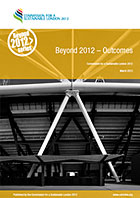
The preparations for and the staging of the London 2012 Games will inherently mean that there is a net increase in the UK’s contribution to global carbon emissions. Since 2006, the Commission has urged the London 2012 key stakeholders to treat carbon management as a strategic issue; to define, measure, reduce and mitigate the negative impacts in an open and transparent way.
London 2012 is the first summer Games to do a carbon footprint study that takes into account embodied and operational emissions from bid win to closing ceremony.
Carbon Footprint Study
London 2012 published a Carbon Footprint Study in March 2010. This sets out the methodology used to estimate the reference footprint and assumptions behind elements of it.
Reference footprint: Responsibility by component
| ktCO2e | Owned – ODA | Owned – LOCOG | Shared + Associated | Total |
| Venues | 1,728 | - | - | 1,728 |
| Transport infrastructure | 161 | 1 | 429 | 591 |
| Spectators | - | 15 | 655 | 670 |
| Operations | - | 384 | 75 | 459 |
| Total | 1,889 | 400 | 1,159 | 3,448 |
Source: London 2012 Carbon Footprint Study
Carbon Management Strategy
London 2012 has not published a stand alone Carbon Management Strategy. Details of the approach to measuring and reporting on the actual carbon footprint are set out in the climate change section of the London 2012 Sustainability Plan, published in December 2009.
Commitments
London’s bid to host the 2012 Olympic and Paralympic Games contained the promise to host the most sustainable Games ever. A sustainable Games is synonymous with a low carbon Games. The ODA and LOCOG have made a number of carbon-related commitments which are set out in the ODA’s Sustainable Development Strategy published in January 2007 and the London 2012 Sustainability Plan published in December 2009. Information on progress made towards these commitments can be found in the London 2012 Sustainability Report: A blueprint for change (2001).
The Commission
The Commission commends the ground breaking work led by LOCOG to define the carbon footprint. In December 2009, we published “Extinguishing Emissions?”, a review of the approach taken to carbon measurement and management across the London 2012 programme. This made a series of recommendations clustered around the following themes:
- Measuring the carbon footprint
- Taking responsibility for the carbon footprint
- Mitigation of the residual footprint
The report contains:
- a snapshot of performance against energy-related commitments at September 2009
- a summary of carbon-related commitments
We have also covered carbon management in our Annual Reports and further information on renewable energy can be found in our case study on this.
